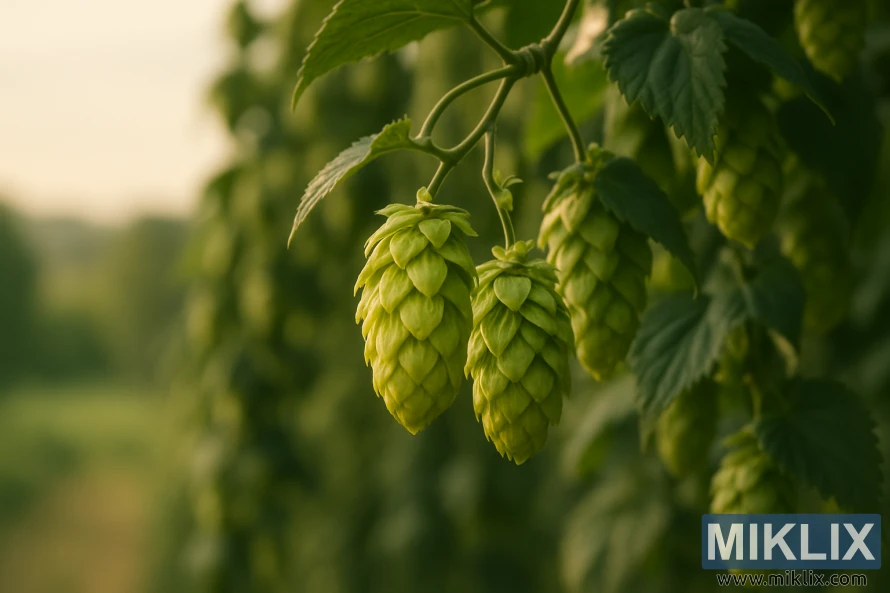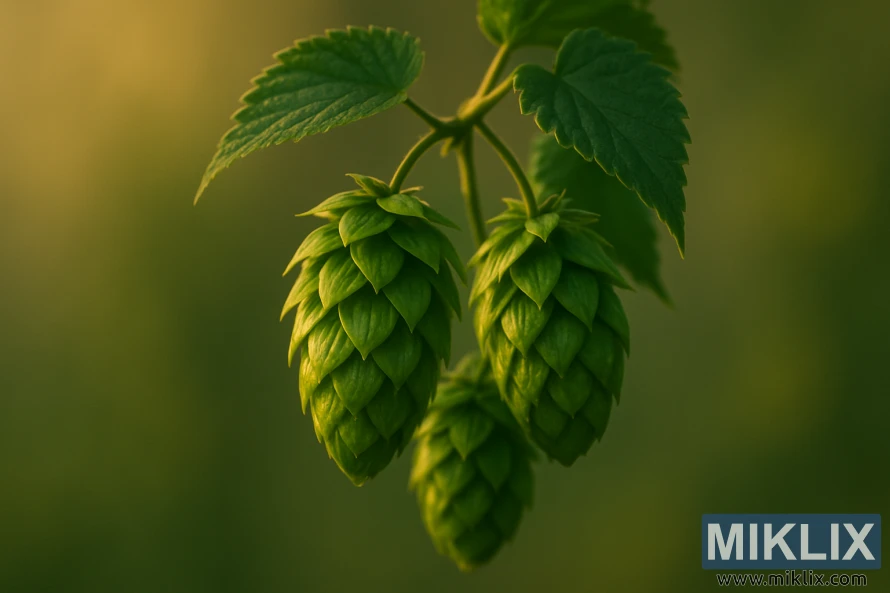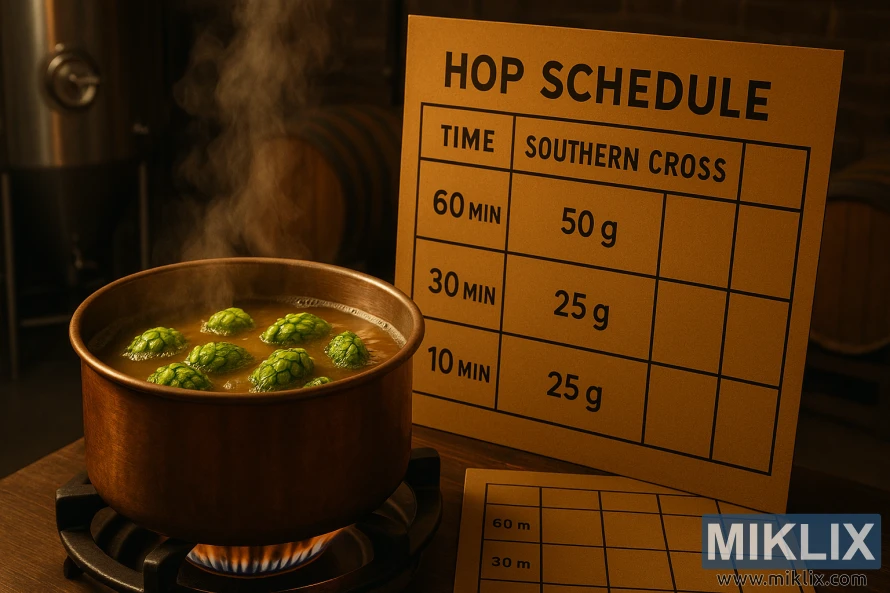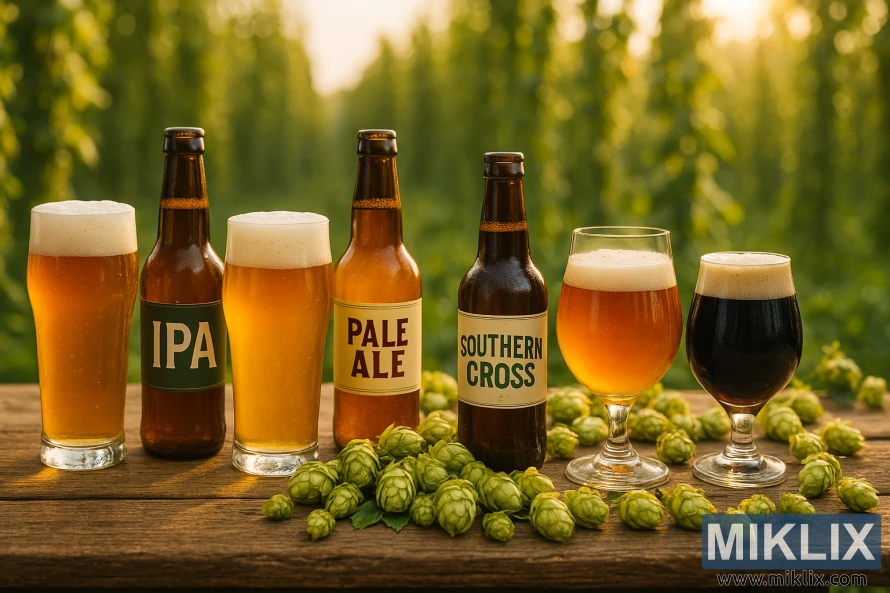Hops in Beer Brewing: Southern Cross
Published: October 29, 2025 at 10:06:51 PM UTC
Southern Cross, developed in New Zealand, was introduced by HortResearch in 1994. It is a triploid cultivar, known for seedless cones and early to mid-season maturity. This makes it a reliable choice for both commercial growers and homebrewers. Its creation involved breeding New Zealand Smooth Cone with a mix of California and English Fuggle varieties, resulting in a dual-purpose hop.

Brewers appreciate Southern Cross for its clean bitterness and bold citrus-pine aroma. It offers notes of lemon, woody spice, and resin. Its versatility makes it suitable for various brewing stages, from kettle additions to late aroma charges. It's gaining popularity in northern-hemisphere craft brewing, enhancing wheat beers, saisons, and pale ales with its vivid hop character.
While some suppliers offer lupulin-enhanced products, there are no Cryo or LupuLN2 versions of Southern Cross from major suppliers like Yakima Chief Hops, BarthHaas, or S&V Hopsteiner. Despite this, Southern Cross remains a practical choice for brewers. Its consistent yields and good postharvest stability make it an excellent option for those seeking a distinct New Zealand hop character without the need for specialized processing.
Key Takeaways
- Southern Cross is a New Zealand-developed hop (SOX) released in 1994.
- It is a triploid, dual-purpose variety with clean bitterness and bold citrus-pine aroma.
- The Southern Cross hop profile suits wheat beers, saisons, and pale ales.
- No Cryo or lupulin powder versions are widely available from major suppliers.
- Reliable yields and good storage stability make it practical for brewers.
What are Southern Cross hops and their origin
Southern Cross hops were introduced in 1994, hailing from New Zealand. HortResearch, a renowned breeding institution, created this triploid variety. It's designed for both bittering and aroma applications. The triploid characteristic ensures the plants are seedless and sterile, impacting their propagation and breeding.
The Southern Cross hop's lineage is a blend of genetic sources. It combines a New Zealand research line from the 1950s, a California hop, and the English Fuggle. This combination results in a hop with a clean bitterness and citrus and pine aromas. These qualities are highly sought after by brewers.
HortResearch aimed to create a versatile hop with Southern Cross. They measured its oil and alpha-acid levels to meet brewing requirements. This effort has yielded a hop that provides robust bitterness while also offering aromatic complexity when used in later stages of brewing.
Flavor and aroma profile of Southern Cross hops
Southern Cross hops introduce a vibrant, citrus-centric profile that shines in both aroma and taste. The flavor profile is dominated by lemon and lime, with a zesty quality. This makes them ideal for late boil additions and dry hopping.
These hops also exhibit a piney undertone. The taste reveals a soft pine resin and woody spice beneath the citrus. The bitterness is perceived as gentle, allowing the aroma compounds to take center stage.
Myrcene and farnesene contribute to floral and fruity esters, enhancing the Southern Cross aroma. This blend includes tropical fruit notes like guava and passion fruit. The outcome is a layered, juicy sensation.
Caryophyllene and humulene add spice and balsamic notes. Brewers can anticipate subtle woody spice and resinous depth. These elements balance the citrus and tropical fruit hops without overpowering them.
Choose Southern Cross hops for a lively, clean citrus flavor with a hint of pine and tropical complexity. The aroma is fresh, zesty, and slightly floral. The palate finishes softly and rounded.

Brewing values and chemical analysis
Southern Cross alpha acids usually range from 11–14%, with many samples around 12.5%. Beta acids are typically 5–7%, leading to an alpha:beta ratio of 2:1 to 3:1. This ratio ensures consistent bitterness in both lagers and ales.
The co-humulone in Southern Cross is about 25–28% of the alpha fraction. This level contributes to a smoother bitterness perception compared to hops with higher co-humulone percentages.
Southern Cross total oils range from 1.2–2.0 mL/100g, averaging 1.6 mL. The oil profile is dominated by myrcene, often the major terpene. It is accompanied by humulene, caryophyllene, and farnesene in smaller amounts.
- Myrcene: resinous, citrus, and fruity; found 31–59% in samples.
- Humulene: woody, spicy, noble; typically 13–17%.
- Caryophyllene: peppery, herbal; around 4–6.5%.
- Farnesene and minor terpenes: fresh, floral, and green.
Hop chemical analysis reveals batch-to-batch consistency in Southern Cross. This consistency aids commercial brewers in maintaining flavor targets. The consistent total oils and terpene ratios minimize the need for recipe adjustments between harvests.
Some lab tests report alpha acid spikes to 12–14.5% and beta acids near 6–6.4%. These tests also show occasional myrcene proportion variations. Such variations can alter the perceived citrus or floral traits.
For process control, hop chemical analysis data is crucial. It guides adjustments in kettle additions, whirlpool timing, and dry-hop rates. Monitoring Southern Cross alpha acids, total oils, and co-humulone across lots ensures stable bitterness and aroma.
How to use Southern Cross hops in the brew kettle
When using Southern Cross hops, start with a measured early charge for base bitterness. Then, add smaller late doses to enhance citrus and spice notes. This approach ensures flavors are layered, preventing any one from overpowering the others.
Alpha acids in Southern Cross can reach 12–14.5%, which means you can expect a significant bitterness. Yet, the perceived bitterness is softer than the numbers indicate. If you prefer a firmer bitterness, add the first dose at 60 minutes. For a gentler bitterness, trim the boil time while preserving hop character.
Save a portion of hops for the last 10–5 minutes to protect volatile oils. These late additions bring out lemon zest, pine needle top notes, and a clean spicy edge. This method adds a fragrant lift that complements pale malts and modern yeast strains.
For balanced beers, stagger your additions. Start with a base bittering dose, then add a mid-boil flavor dose, and finish with a late aroma splash. Use small whirlpool rests at 170–180°F to extract oils without harshness. This approach makes Southern Cross boil additions both efficient and expressive.
- 60 min: primary bittering IBU, moderate dose
- 20–15 min: flavor development, moderate to low dose
- 10–0 min: aroma focus, small dose for citrus and spice
- Whirlpool: short rest to enhance aromatic lift
Adjust the hop schedule Southern Cross to suit your beer style and malt bill. In hop-forward ales, increase late additions. For balanced lagers, emphasize earlier hops but keep a late touch for clarity in Southern Cross bitterness and aromatics.

Dry hopping and fermentation additions
Southern Cross is perfect for late boil and fermentation additions due to its high essential oils and low co-humulone. It's best to use whole cone or pellet forms, as lupulin powder is not available for this variety.
For beers that focus on aroma, add Southern Cross to the whirlpool at low temperatures. This captures the delicate citrus and floral esters. A short contact time of 10–20 minutes is often enough to extract lemon zest and pine without pulling vegetal notes.
Dry hopping can enhance spicy and resinous elements. Add Southern Cross dry hop charges during active fermentation or after primary fermentation for a clean citrus lift.
- Early whirlpool: gentle citrus and mild bitterness.
- Late additions Southern Cross at flameout: brighter top notes and fuller mid-palate.
- Short dry hop contact: peak floral and lemon character; avoid excessive time to reduce grassy tones.
Adjust the contact time based on the beer style. Hazy IPAs can handle longer Southern Cross dry hop contact for layered aroma. Lagers and pilsners, on the other hand, benefit from brief Southern Cross whirlpool additions to keep the profile crisp.
Monitor oil pickup and watch for vegetal extraction when using late additions Southern Cross. Start with conservative grams per liter and scale up in future brews once the balance is confirmed.
Beer styles that pair well with Southern Cross hops
Southern Cross hops are a staple in pale ales, IPAs, and lagers. Their lemon-pine aroma can truly shine in these styles. California and Norway's brewers have showcased the variety in single-hop releases and blends. The hop's soft bitterness complements lighter-bodied beers well.
In IPAs, Southern Cross enhances bright citrus notes without overpowering the malt. Late kettle additions and dry hopping are key to preserving the hop's volatile aromatics. This method brings out the lemon peel and resinous pine flavors.
Citrusy lagers and fruity pale ales benefit from Southern Cross's clean profile. For those seeking the best beers with Southern Cross, consider saisons and wheat beers. These styles require subtle spice and floral lift, which Southern Cross complements with its integration with yeast-driven esters.
Try Southern Cross in a pale ale as a single-hop showcase or blend it with Nelson Sauvin or Citra for tropical depth. Craft brewers often choose Southern Cross for its aroma prominence and light mouthfeel, making it perfect for sessionable beers.
- Pale Ale — single-hop expression to show lemon-pine aroma.
- IPA — late additions and dry hop emphasize Southern Cross in IPAs.
- Lager — clean citrus lift for modern, crisp lagers.
- Wheat Beer & Saison — gentle bitterness and aromatic support.
When crafting beers with Southern Cross, match your hopping schedule to your desired outcome. For aroma-forward beers, focus on hop stand and dry hopping. For bittering balance, use measured early additions and let the malt bill carry the body. These strategies will help you create some of the best beers with Southern Cross.

Blending Southern Cross with other hop varieties
Southern Cross balances old-world structure with new-world brightness. It adds citrus and pine clarity while maintaining a firm bitter backbone. When blending Southern Cross, consider enhancing tropical fruit, resinous pine, or floral notes.
Experienced brewers recommend Sorachi Ace as a substitute for lemony top notes. For true blending, choose hops that contrast in oils. Mosaic adds fruity depth, Nelson Sauvin brings white grape and tropical lift, and Cascade offers classic citrus.
Choose complementary hops that supply caryophyllene or fruity esters. These balance Southern Cross's floral myrcene and balsamic humulene. A light touch of Amarillo or Citra in late additions can highlight orange and tropical notes, enhancing Southern Cross's cleaner bitterness.
- Use a resinous hop like Simcoe or Chinook for pine and resin in the foreground.
- Pick a fruity hop such as Mosaic, Nelson Sauvin, or Citra for tropical and stone fruit characters.
- Try subtle additions of Saaz or Hallertauer for a gentle floral-spicy edge that complements humulene.
In multi-hop recipes, start with Southern Cross at bittering, then split late and dry-hop additions. Use a fruity variety and a resinous variety. This keeps the beer balanced and layered. Keep records of ratios and steep times for future success.
Substitutes and alternatives for Southern Cross hops
When Southern Cross is out of stock, brewers rely on data and tasting notes to find suitable substitutes. Sorachi Ace is often recommended as an alternative. It is praised for its bright lemon character and clean, herbaceous backbone.
To replicate the lemon-pine-spice profile, brewers seek hops with strong citrus top notes and a fresh pine finish. They look for varieties with comparable alpha acid ranges to maintain bittering balance in the boil.
- Use Sorachi Ace alternative in late kettle additions for that citrus lift.
- Try New Zealand varieties with similar oil ratios when aiming for pine and resin.
- Blend hops similar to Southern Cross for a layered spice and lemon aroma.
The oil profile is crucial. Choose substitutes with myrcene and humulene proportions that mimic Southern Cross to keep perceived bitterness soft. Adjust your hopping schedule toward late additions and dry-hop timing to reproduce delicate aromatics.
Small test batches are recommended. Swap in a proposed Southern Cross substitute at 20–30% of total hop mass, then tweak rates and timing based on aroma intensity. This empirical approach helps you replicate the signature notes without losing balance.

Availability, formats, and purchasing tips
Southern Cross seeds and cones are shipped from New Zealand by various hop merchants and online retailers. In the United States, brewers can find Southern Cross hops through specialty suppliers, farm-direct shops, and Amazon. It's crucial to compare the harvest year and packaging before making a purchase to guarantee freshness.
The majority of Southern Cross hops are sold as pellets. Pellets are easier to handle, store, and measure for both kettle and dry hop additions. Currently, no major supplier offers Southern Cross in lupulin powder forms like Cryo or Lupomax. Thus, pellets are the main choice for brewers.
Availability of Southern Cross hops can fluctuate with the season and demand. While its popularity has increased globally, stocks are still limited compared to well-known varieties like Citra or Centennial. Be prepared for limited availability during the initial international adoption phase. Always check multiple vendors when planning your brews.
Timing is essential. New Zealand's harvest season spans from late February to early April. Opt for current-year harvests for the best oil profile. Review the supplier's notes on harvest date, storage method, and cold-chain handling to preserve the hop's volatile aromatics and character.
Here's a checklist for buying Southern Cross hops:
- Verify the harvest year and storage temperature.
- Prefer vacuum-sealed or nitrogen-flushed packaging.
- Ask the seller about inventory turnover to avoid stale lots.
- Compare pricing across suppliers; amounts and pellet size may differ.
For small batches or one-off brews, order modest quantities and test the aroma in a dry-hop trial. For larger commercial runs, establish relationships with reputable suppliers like Yakima Chief Hops distributors or regional hop houses. Regularly check Southern Cross availability to secure the right lot for your recipe.
Storage, stability, and harvest season
Southern Cross hops ripen in the early to mid season. New Zealand harvests usually occur from late February to early April. Growers find consistent oil profiles, but aroma quality depends on freshness and post-picking handling.
For aromatic uses, store Southern Cross hops from recent harvests with care. This ensures the floral and myrcene-driven notes remain vibrant for dry hopping and late additions.
Effective hop storage involves vacuum-sealing and freezing. These methods slow oxidation and preserve volatile oils. Southern Cross is relatively stable postharvest, but improper storage can mute its topnotes.
- Verify harvest dates when purchasing to match the Southern Cross harvest season.
- Store hops in opaque, oxygen-barrier bags to minimize light and air exposure.
- Freeze at or below -18°C (0°F) for extended storage.
For short-term storage at the brewery, use cold rooms with controlled humidity and minimal air exchange. Homebrewers can store small vacuum-sealed packs in a household freezer.
Remember, essential oils are volatile. Plan hop usage to ensure the most aromatic cones are used in late kettle additions, whirlpool hops, or dry hopping. This strategy maximizes aroma retention after proper hop storage.
Commercial and craft brewer use cases
Breweries opting for Southern Cross frequently purchase whole-cone or pellet formats from various suppliers. The volume, harvest year, and pricing can vary by lot. Thus, commercial buyers meticulously review certificates of analysis before scaling up their production.
In the realm of Southern Cross commercial use, large-scale lagers greatly benefit from its clean bitterness and restrained oil profile. This characteristic makes it easier to achieve consistency across batches. It also helps in maintaining low haze and flavor drift.
On the other hand, small breweries prefer Southern Cross for its citrus and tropical aromatics. Microbreweries in California and Norway incorporate it into wheat beers, saisons, and pale ales. This enhances aroma without introducing harsh bitterness.
- Single-hop releases: showcase bright grapefruit and passionfruit notes for taproom pours.
- Component in blends: pairs well with Nelson Sauvin or Mosaic for layered fruit character.
- Session beers: soft perceived bitterness supports drinkability in low-ABV recipes.
Given the absence of cryo or lupulin-concentrate formats, brewers adapt their recipes. They adjust rates and timing to ensure predictable aroma extraction. This approach is crucial for both commercial and craft-scale brewing.
Before fully adopting Southern Cross, breweries often conduct pilot brews. These tests help compare different lots. Tasting panels focus on aroma lift, hop backbalance, and how the hop interacts with yeast esters in ales and lagers.
Distribution centers and ingredient brokers are the primary suppliers of Southern Cross. For craft breweries, securing consistent lots during harvest season is essential. It minimizes the need for reformulation and keeps brand recipes consistent.
Practical homebrewing recipes and tips with Southern Cross
Southern Cross is a versatile hop, suitable for every stage of brewing. For recipes, incorporate it in late-boil and whirlpool additions. This will highlight its lemon, lime, pine, and spice flavors.
Choose between pellet or whole-leaf forms since lupulin powder is not available. When switching from cryo to pellets, slightly increase hop mass or contact time. This ensures the desired aromatic depth.
When using Southern Cross for bittering, be cautious with alpha acids. With alpha ranges around 12–14.5%, moderate kettle hops are recommended. This approach helps maintain balance in pale ales or saisons.
Here are some recipe ideas to explore Southern Cross:
- Single-hop pale ale: boil lightly, whirlpool at 175°F for 15 minutes, then dry hop.
- New England–style IPA: heavy late additions, whirlpool at 170–185°F, and a generous dry hop.
- Citrus lager: modest late hopping, short cold dry hop for brightness.
- Saison: split additions through late boil and dry hop for peppery citrus lift.
Adopt a structured Southern Cross hop schedule for your additions. Start with 15 IBUs early, add 10–20 minutes late for flavor, whirlpool at 175–185°F for aroma, and dry hop after primary fermentation.
For dry hopping, aim for 3–7 days of contact. This brings out bright lemon and pine notes without vegetal flavors. These tips help avoid over-extraction and keep hops fresh in the final beer.
Store hops frozen and use them within a year for the best aromatics. Measure additions by weight, not volume, to account for pellet density and to match the hop schedule in scaled recipes.
Keep a log of each trial batch. Record pellet form, addition times, whirlpool temperatures, and dry hop duration. This log will help refine your Southern Cross recipes over time, leading to consistent results.
Conclusion
Southern Cross summary: This New Zealand hop is a dual-purpose gem, offering bright citrus, tropical fruit, pine, and spice notes. It also provides usable bittering power. Bred by HortResearch in 1994, it combines clean bitterness with expressive aromatics. Its average alpha acids near 12.5% make it a dependable choice for modern ales and saisons.
Why use Southern Cross hops is evident for both commercial and home brewers. Its perceived bitterness is softer than its numbers suggest. This makes it blend well into pale ales, wheat beers, and saisons without overpowering delicate malt profiles. The hop’s strong essential oil content and stability after harvest make it reliable for late-kettle additions and dry hopping.
Southern Cross hop benefits include predictable flavor intensity and versatile dual-purpose use. It also has good storage characteristics. Widely available through multiple suppliers, it is a practical, aromatic option for brewers. When you need lemon-pine clarity with subtle tropical and spice layers, Southern Cross is a smart choice. It remains a valuable tool in the hop toolbox for brewers seeking balance and character.
Further Reading
If you enjoyed this post, you may also like these suggestions:
